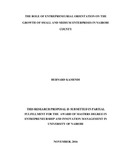| dc.contributor.author | kamendi, Bernard | |
| dc.date.accessioned | 2016-12-23T08:14:03Z | |
| dc.date.available | 2016-12-23T08:14:03Z | |
| dc.date.issued | 2016 | |
| dc.identifier.uri | http://hdl.handle.net/11295/98436 | |
| dc.description.abstract | The entrepreneurial orientation of an organization is described as a dimension of strategic posture represented by a firm's risk taking propensity and the tendency to act in a competitively aggressive, proactive manner while relying frequently on product innovation. Organizations are said to have entrepreneurial orientation when a group of innovative members of the organization work together to produce fresh ideas and they are accorded a conducive atmosphere to act on those ideas .Small and Medium enterprises (SMEs) play an important economic role in many countries the world over. The background information of the study indicates that SMEs are faced by constant threat of failure and most do not graduate into large enterprises. Past studies indicate that the SMEs sector in Kenya is characterized by high mortality rate for every five started three fail before the sixth month; over 60% fail each year; and most do not survive to their third anniversary. Nairobi County receives the highest revenue allocation to counties accounting for approximately 10% of the total national allocation (Kenya National Bureau of Statistics, 2015). The county‟s infrastructure is relatively well developed with a good communications system. It‟s the country‟s industrial base, is estimated to account for 20% of the country‟s GDP. In spite of their economic importance to the county, the failure rate of SMEs in Nairobi is between 70% and 80%. This casts doubt on this sector‟s ability to create and sustain employment which reduces poverty. The lack of SME growth in Nairobi could perhaps be attributed to them lacking the needed entrepreneurial orientation. The study sought to investigate the role of entrepreneurial orientation on the growth of small and medium enterprises in Nairobi County. The research study used an exploratory research study. The target population was the registered SMEs in Nairobi County. This comprised a total of all the 2248 registered SMEs business with Nairobi County. The sample size of this study was therefore 226 SME respondents. Data collection was done using semi-structure questionnaires. A descriptive analysis was employed. Multiple regressions were used to measure the quantitative data which was analyzed using SPSS. Tables and other graphical presentations were used to present the data collected for ease of analysis and interpretation. Risk taking was found to be a critical factor of entrepreneurial orientation on the growth of small and medium enterprises. In terms of magnitude, the findings indicated that risk taking had the highest effect on growth of Nairobi Smes followed by Pro-activeness, then innovativeness which had the least effect on growth of small and medium enterprises. All the variables were significant as their P-values were less than 0.05. It can be concluded that risk taking has the highest effect on growth of small and medium enterprises. The study recommends that the small and medium enterprises owners should invest in research and development to come up with new products and services that would be competitive in the market. SMEs owners should pursue new markets and apply new business processes like outsourcing to enhance business growth. | en_US |
| dc.language.iso | en | en_US |
| dc.publisher | University of Nairobi | en_US |
| dc.rights | Attribution-NonCommercial-NoDerivs 3.0 United States | * |
| dc.rights.uri | http://creativecommons.org/licenses/by-nc-nd/3.0/us/ | * |
| dc.subject | The Role of Entrepreneurial Orientation on the Growth of Small and Medium Enterprises | en_US |
| dc.title | The Role of Entrepreneurial Orientation on the Growth of Small and Medium Enterprises in Nairobi County | en_US |
| dc.type | Thesis | en_US |



